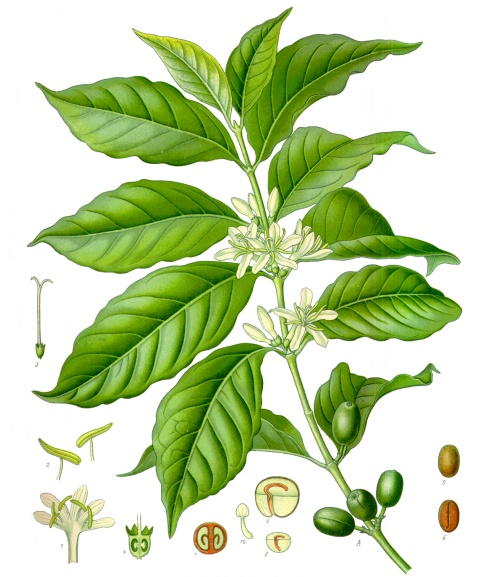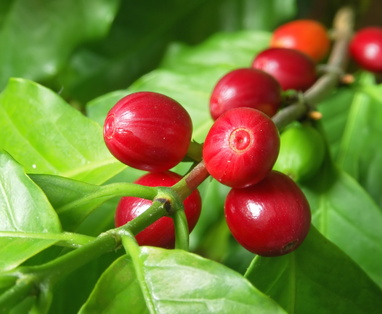Coffee arabica (L)
Synonym: Caffea
Order: Rubiaceae
Description: Coffee is a native of south-west Ethiopia, but is cultivated throughout the tropics. In the wild, the tree reaches a height of 10m but is kept shorter in cultivation. It has evergreen leaves, smooth and shiny on the upper side, 15cm long, 6cm wide, with white flowers in dense clusters at base of the leaves. The berries are red and fleshy, each two-seeded, convex on one side, flat on the other with a long furrowed line running lengthways and covered with a thin parchment.
Parts used: kernel of the dried ripe seed
Constituents: oil, wax, caffeine (more caffeine in fresh than in roasted coffee), aromatic oil, tannic acid, caffetannic acid, gum, sugar, protein, B vitamins
Actions: brain stimulant, soothing action on vascular system, diuretic, antinarcotic, antiemetic.
Indications:
Therapeutics and Pharmacology: In acute cases of narcotic poisoning coffee can be injected into the rectum. It is said to ward off coma in cases of snakebite. Caffeine is valuable for heart disease, ascites and pleuritic effusion, and also in cases of inebriety. Coffee is rarely used medicinally, but caffeine is a frequent ingredient of many orthodox analgesic preparations as it potentiates the effect of paracetamol and aspirin and produces a feeling of well-being.
Combinations: Combines well with digitalis in the treatment of heart disease.
 Caution: excessive amounts may cause
sleeplessness and tachycardia.
Caution: excessive amounts may cause
sleeplessness and tachycardia.
Additional Comments: The name Coffee is derived from Caffa, a province of Abyssinia (Ethiopia). The coffee shrub was introduced into Arabia in the fifteenth century and for two hundred years Arabia supplied the world's coffee. At the end of the seventeenth century the Dutch introduced the plant into Batavia, from where a plant was presented to Louis XIV of France in 1714. All the coffee now imported from Brazil has come from that single plant.
Bibliography
Grieve, M. 1931 A Modern Herbal, (ed. C.F. Leyel 1985), London.
Wren, R.C. 1988 Potter's New Cyclopaedia of Botanical Drugs and Preparations, C.W.Daniel, Saffron Walden.










